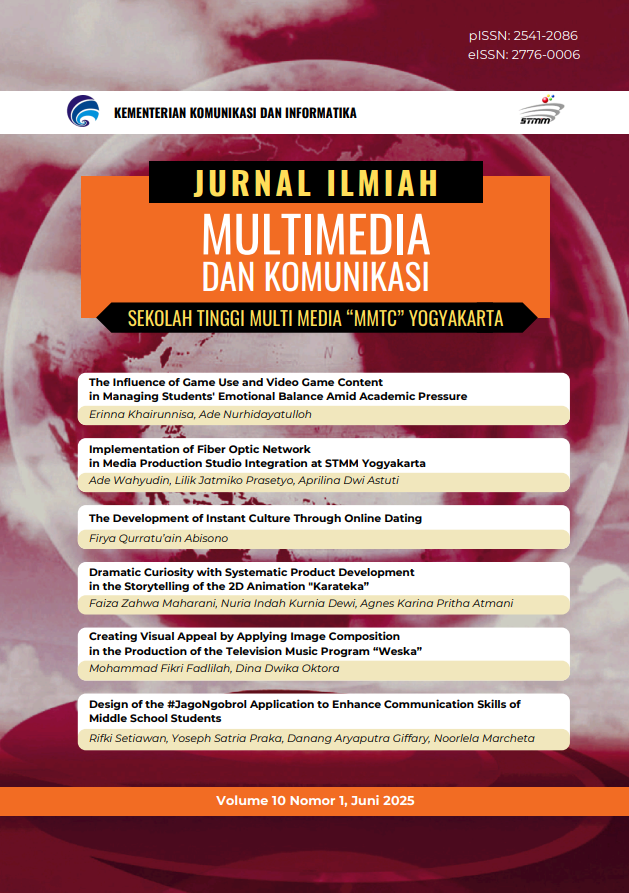Implementation of Fiber Optic Network in Media Production Studio Integration at STMM Yogyakarta
DOI:
https://doi.org/10.56873/jimk.v10i1.482Keywords:
Fiber Optic Networks, Network Quality, Media Broadcasting, Studio Integration, Transmission EfficiencyAbstract
This study aims to evaluate the implementation of fiber optic networks to improve integration and transmission efficiency in the media production studios at STMM Yogyakarta. In broadcasting environments, network stability and high-speed data transmission are essential to ensure seamless delivery of high-quality audio-visual content. Optical fiber, known for its superior bandwidth and low latency, presents a suitable technological solution. Through experimental testing using Wireshark software, this research measures key network parameters—throughput, delay, packet loss, and jitter—in two studio environments. The results reveal that Studio 2 demonstrates optimal performance with a maximum throughput of 11,286.42 Kbps, an average delay of 2.98 ms, 0% packet loss, and minimal jitter. In contrast, Studio 1 exhibits lower throughput, higher delay and jitter, and packet loss of up to 5.5%, indicating the need for technical improvement. The study highlights a research gap regarding fiber optic implementation in educational broadcast studios and offers practical recommendations such as network configuration optimization, equipment upgrades, and Quality of Service (QoS) implementation. These findings are expected to enhance practicum quality and align the learning environment more closely with industry standards.Downloads
References
Dai, M. (2020). Research on Networking Technology of Digital Terrestrial Television Single Frequency Network. 2020 International Wireless Communications and Mobile Computing, IWCMC 2020, 525–529. https://doi.org/10.1109/IWCMC48107.2020.9148264
Goff, D. (2020). Fiber Optic Fundamentals. In Fiber Optic Reference Guide. https://doi.org/10.4324/9780080506319-6
Hiraoka, Y. (2022). Development of Broadcast receiver for ultra-high-definition TV using RoF technology by GI-POF. Proceedings of SPIE - The International Society for Optical Engineering, 12025. https://doi.org/10.1117/12.2614530
Kaur, S., Singh, P., Tripathi, V., & Kaur, R. (2022). Recent trends in wireless and optical fiber communication. Global Transitions Proceedings, 3(1), 343–348. https://doi.org/10.1016/j.gltp.2022.03.022
Saglik, M., & Ozturk, S. (2001). Television as an Educational Technology: Using Television at Open Education Faculty, Anadolu University. Turkish Online Journal of Distance Education, 2(1), 74–82. https://doi.org/10.17718/tojde.13218
Sjøvaag, H., Olsen, R. K., & Ferrer-Conill, R. (2024). Delivering content: Modular broadcasting technology and the role of content delivery networks. Telecommunications Policy, 48(4). https://doi.org/10.1016/j.telpol.2024.102738
Downloads
Additional Files
Published
Issue
Section
License
Penulis yang menerbitkan artikel di jurnal ini menyetujui ketentuan berikut:
1. Hak Cipta tetap pada penulis dan memberikan hak kepada Jurnal Ilmiah Komunikasi dan Multimedia sebagai otoritas untuk menerbitkan artikel dengan Lisensi Creative Commons Atribusi 4.0 Internasional, yang memungkinkan artikel untuk dibagikan dengan sepengetahuan penulis artikel dan jurnal ini sebagai tempat publikasi.
2. Penulis dapat mendistribusikan publikasi artikelnya secara non-eksklusif (misalnya: pada repositori universitas atau buku) dengan pemberitahuan atau pengakuan publikasi di jurnal Option.
3. Penulis diperbolehkan memposting karyanya secara online (misalnya: di situs pribadi atau di repositori universitas) sebelum dan sesudah proses penyerahan (lihat Pengaruh Akses Terbuka)









